AEG-Electrolux S60360KG8 User Manual
S60360KG8
User manual |
Fridge Freezer |
Notice d'utilisation |
Réfrigérateur/ |
|
congélateur |
Benutzerinformation |
Kühl - Gefrierschrank |
Istruzioni per l’uso |
Frigo-Congelatore |

2 Contents
Thank you for choosing one of our high-quality products.
To ensure optimal and regular performance of your appliance please read this instruction manual carefully. It will enable you to navigate all processes perfectly and most efficiently. To refer to this manual any time you need to, we recommend you to keep it in a safe place. And please pass it to any future owner of the appliance.
We wish you much joy with your new appliance.
CONTENTS
SAFETY INFORMATION |
2 |
Children and vulnerable people safety |
3 |
|
|
General safety |
3 |
Daily Use |
4 |
Care and cleaning |
4 |
Installation |
4 |
Service |
5 |
OPERATION |
5 |
Switching on |
5 |
Switching off |
5 |
Temperature regulation |
5 |
FIRST USE |
6 |
Cleaning the interior |
6 |
DAILY USE |
6 |
Freezing fresh food |
6 |
Storage of frozen food |
6 |
Thawing |
6 |
Movable shelves |
7 |
Bottle rack |
7 |
Vegetable Drawer |
7 |
Positioning the door shelves |
8 |
Removal of freezing baskets from the |
|
freezer |
8 |
HELPFUL HINTS AND TIPS |
9 |
Normal Operating Sounds |
9 |
Hints for energy saving |
9 |
Hints for fresh food refrigeration |
9 |
Hints for refrigeration |
9 |
Hints for freezing |
9 |
Hints for storage of frozen food |
10 |
CARE AND CLEANING |
10 |
Periodic cleaning |
10 |
Defrosting of the refrigerator |
11 |
Defrosting the freezer |
11 |
WHAT TO DO IF… |
12 |
Replacing the lamp |
13 |
Closing the door |
14 |
TECHNICAL DATA |
14 |
INSTALLATION |
14 |
Positioning |
14 |
Location |
15 |
Electrical connection |
15 |
Rear spacers |
15 |
Levelling |
16 |
Removing the shelf holders |
16 |
Door reversibility |
16 |
ENVIRONMENTAL CONCERNS |
18 |
Subject to change without notice
SAFETY INFORMATION
In the interest of your safety and to ensure the correct use, before installing and first using the appliance, read this user manual carefully, including its hints and warnings. To avoid unnecessary mistakes and accidents, it is important to ensure that all people using the appliance are thoroughly familiar with its operation and safety features. Save these

Safety information |
3 |
|
|
instructions and make sure that they remain with the appliance if it is moved or sold, so that everyone using it through its life will be properly informed on appliance use and safety. For the safety of life and property keep the precautions of these user's instructions as the manufacturer is not responsible for damages caused by omission.
Children and vulnerable people safety
•This appliance is not intended for use by persons (including children) with reduced physical, sensory or mental capabilities, or lack of experience and knowledge, unless they have been given supervision or instruction concerning use of the appliance by a person responsible for their safety.
Children should be supervised to ensure that they do not play with the appliance.
•Keep all packaging well away from children. There is risk of suffocation.
•If you are discarding the appliance pull the plug out of the socket, cut the connection cable (as close to the appliance as you can) and remove the door to prevent playing children to suffer electric shock or to close themselves into it.
•If this appliance featuring magnetic door seals is to replace an older appliance having a spring lock (latch) on the door or lid, be sure to make that spring lock unusable before you discard the old appliance. This will prevent it from becoming a death trap for a child.
General safety
CAUTION!
Keep ventilation openings clear of obstruction.
•The appliance is intended for keeping foodstuff and/or beverages in a normal household as explained in this instruction booklet.
•Do not use a mechanical device or any artificial means to speed up the thawing process.
•Do not use other electrical appliances (such as ice cream makers) inside of refrigerating appliances, unless they are approved for this purpose by the manufacturer.
•Do not damage the refrigerant circuit.
•The refrigerant isobutane (R600a) is contained within the refrigerant circuit of the appliance, a natural gas with a high level of environmental compatibility, which is nevertheless flammable.
During transportation and installation of the appliance, be certain that none of the components of the refrigerant circuit become damaged.
If the refrigerant circuit should become damaged:
–avoid open flames and sources of ignition
–thoroughly ventilate the room in which the appliance is situated
•It is dangerous to alter the specifications or modify this product in any way. Any damage to the cord may cause a short-circuit, fire and/or electric shock.
WARNING!
Any electrical component (power cord, plug, compressor) must be replaced by a certified service agent or qualified service personnel.
1.Power cord must not be lengthened.
2.Make sure that the power plug is not squashed or damaged by the back of the appliance. A squashed or damaged power plug may overheat and cause a fire.

4Safety information
3.Make sure that you can come to the mains plug of the appliance.
4.Do not pull the mains cable.
5.If the power plug socket is loose, do not insert the power plug. There is a risk of electric shock or fire.
6.You must not operate the appliance without the lamp cover1) of interior lighting.
•This appliance is heavy. Care should be taken when moving it.
•Do not remove nor touch items from the freezer compartment if your hands are damp/ wet, as this could cause skin abrasions or frost/freezer burns.
•Avoid prolonged exposure of the appliance to direct sunlight.
•Bulb lamps2) used in this appliance are special purpose lamps selected for household appliances use only. They are not suitable for household room illumination.
Daily Use
•Do not put hot pot on the plastic parts in the appliance.
•Do not store flammable gas and liquid in the appliance, because they may explode.
•Do not place food products directly against the air outlet on the rear wall.3)
•Frozen food must not be re-frozen once it has been thawed out.
•Store pre-packed frozen food in accordance with the frozen food manufacturer's instructions.
•Appliance's manufacturers storage recommendations should be strictly adhered to. Refer to relevant instructions.
•Do not place carbonated or fizzy drinks in the freezer compartment as it creates pressure on the container, which may cause it to explode, resulting in damage to the appliance.
•Ice lollies can cause frost burns if consumed straight from the appliance.
Care and cleaning
•Before maintenance, switch off the appliance and disconnect the mains plug from the mains socket.
•Do not clean the appliance with metal objects.
•Do not use sharp objects to remove frost from the appliance. Use a plastic scraper.
•Regularly examine the drain in the refrigerator for defrosted water. If necessary, clean the drain. If the drain is blocked, water will collect in the bottom of the appliance.
Installation
For electrical connection carefully follow the instructions given in specific paragraphs.
•Unpack the appliance and check if there are damages on it. Do not connect the appliance if it is damaged. Report possible damages immediately to the place you bought it. In that case retain packing.
•It is advisable to wait at least four hours before connecting the appliance to allow the oil to flow back in the compressor.
•Adequate air circulation should be around the appliance, lacking this leads to overheating. To achieve sufficient ventilation follow the instructions relevant to installation.
1)If the lamp cover is foreseen
2)If the lamp is foreseen
3)If the appliance is Frost Free
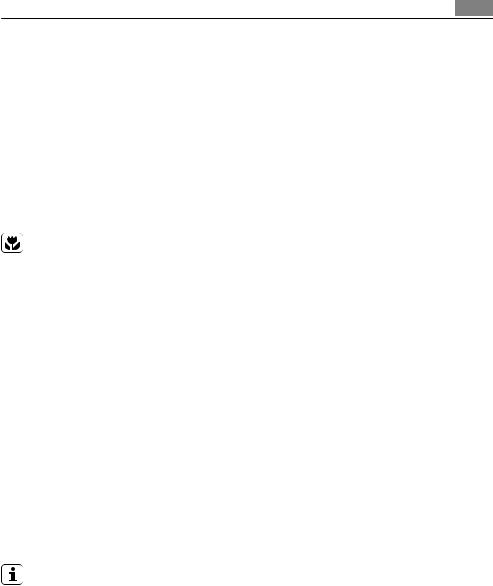
Operation 5
•Wherever possible the back of the product should be against a wall to avoid touching or catching warm parts (compressor, condenser) to prevent possible burn.
•The appliance must not be located close to radiators or cookers.
•Make sure that the mains plug is accessible after the installation of the appliance.
•Connect to potable water supply only.4)
Service
•Any electrical work required to do the servicing of the appliance should be carried out by a qualified electrician or competent person.
•This product must be serviced by an authorized Service Centre, and only genuine spare parts must be used.
Environment Protection
This appliance does not contain gasses which could damage the ozone layer, in either its refrigerant circuit or insulation materials. The appliance shall not be discarded together with the urban refuse and rubbish. The insulation foam contains flammable gases: the appliance shall be disposed according to the applicable regulations to obtain from your local authorities. Avoid damaging the cooling unit, especially at the rear near the heat exchanger. The materials used on this appliance marked by the symbol  are recyclable.
are recyclable.
OPERATION
Switching on
Insert the plug into the wall socket.
Turn the Temperature regulator clockwise to a medium setting.
Switching off
To turn off the appliance, turn the Temperature regulator to the "O" position.
Temperature regulation
The temperature is automatically regulated. To operate the appliance, proceed as follows:
•turn the Temperature regulator toward lower settings to obtain the minimum coldness.
•turn the Temperature regulator toward higher settings to obtain the maximum coldness.
A medium setting is generally the most suitable.
However, the exact setting should be chosen keeping in mind that the temperature inside the appliance depends on:
•room temperature
•how often the door is opened
•the quantity of food stored
•the location of the appliance.
4) If a water connection is foreseen
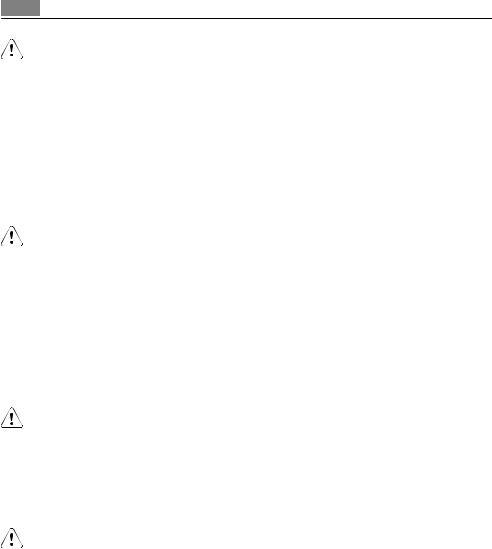
6 First use
If the ambient temperature is high or the appliance is fully loaded, and the appliance is set to the lowest temperatures, it may run continuously causing frost to form on the rear wall. In this case the dial must be set to a higher temperature to allow automatic defrosting and therefore reduced energy consumption.
FIRST USE
Cleaning the interior
Before using the appliance for the first time, wash the interior and all internal accessories with lukewarm water and some neutral soap so as to remove the typical smell of a brand-new product, then dry thoroughly.
Do not use detergents or abrasive powders, as these will damage the finish.
DAILY USE
Freezing fresh food
The freezer compartment is suitable for freezing fresh food and storing frozen and deepfrozen food for a long time.
To freeze fresh foods it is not necessary to change the medium setting.
However, for a faster freezing operation, turn the temperature regulator toward higher settings to obtain the maximum coldness.
In this condition, the refrigerator compartment temperature might drop below 0°C. If this occurs reset the temperature regulator to a warmer setting.
Place the fresh food to be frozen on the top compartment.
Storage of frozen food
When first starting-up or after a period out of use, before putting the products in the compartment let the appliance run at least 2 hours on the higher settings.
In the event of accidental defrosting, for example due to a power failure, if the power has been off for longer than the value shown in the technical characteristics chart under "rising time", the defrosted food must be consumed quickly or cooked immediately and then re-frozen (after cooling).
Thawing
Deep-frozen or frozen food, prior to being used, can be thawed in the refrigerator compartment or at room temperature, depending on the time available for this operation. Small pieces may even be cooked still frozen, directly from the freezer: in this case, cooking will take longer.
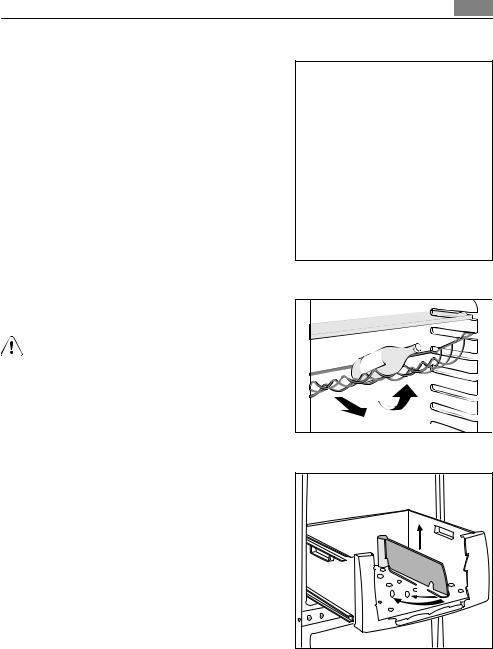
Daily use |
7 |
Movable shelves |
|
The walls of the refrigerator are equipped with a |
|
series of runners so that the shelves can be posi- |
|
tioned as desired. |
|
Bottle rack
Place the bottles (with the opening facing front) in the pre-positioned shelf.
If the shelf is positioned horizontally, place only closed bottles.
This bottle holder shelf can be tilted in order to store previously opened bottles. To obtain this result, pull the shelf up so it can rotate upwards and be placed on the next higher level.
Vegetable Drawer
The drawer is suitable for storing fruit and vegetables.
There is a separator inside the drawer that can be placed in different positions to allow for the subdivision best suited to personal needs.
There is a grille (if foreseen) on the bottom of the drawer to separate the fruit and vegetables from any humidity that may form on the bottom surface.
All parts inside the drawer can be removed for cleaning purposes
1 |
2 |
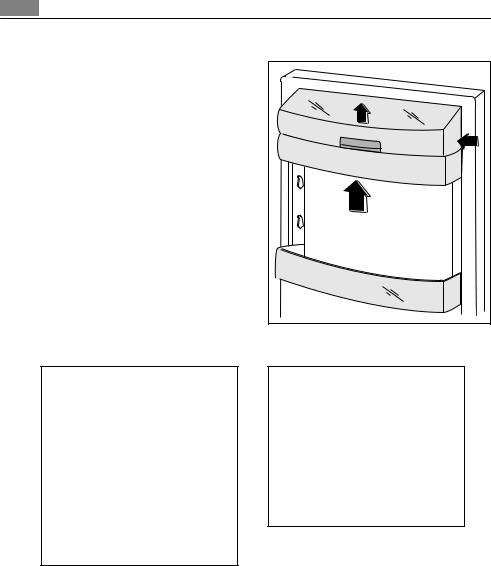
8 Daily use
Positioning the door shelves
To permit storage of food packages of various sizes, the door shelves can be placed at different heights.
To make these adjustments proceed as follows:
gradually pull the shelf in the direction of the arrows until it comes free, then reposition as required.
Removal of freezing baskets from the freezer
2 |
1 |
2 |
1 |
The freezing baskets have a limit stop to prevent their accidental removal or falling out. At the time of its removal from the freezer, pull the basket towards yourself and, upon reaching the end point, remove the basket by tilting its front upwards.
At the time of putting it back, slightly lift the front of the basket to insert it into the freezer. Once you are over the end points, push the baskets back in their position.
Helpful hints and tips |
9 |
|
|
HELPFUL HINTS AND TIPS
Normal Operating Sounds
•You may hear a faint gurgling and a bubbling sound when the refrigerant is pumped through the coils or tubing. This is correct.
•When the compressor is on, the refrigerant is being pumped around and you will hear a whirring sound and a pulsating noise from the compressor. This is correct.
•The thermic dilatation might cause a sudden cracking noise. It is natural, not dangerous physical phenomenon. This is correct.
•When the compressor switches on or switches off, you will hear a faint "click" of the temperature regulator. This is correct.
Hints for energy saving
•Do not open the door frequently or leave it open longer than absolutely necessary.
•If the ambient temperature is high and the Temperature Regulator is set to low temperature and the appliance is fully loaded, the compressor may run continuously, causing frost or ice on the evaporator. If this happens, set the Temperature Regulator toward warmer settings to allow automatic defrosting and so a saving in electricity consumption.
Hints for fresh food refrigeration
To obtain the best performance:
•do not store warm food or evaporating liquids in the refrigerator
•do cover or wrap the food, particularly if it has a strong flavour
•position food so that air can circulate freely around it
Hints for refrigeration
Useful hints:
Meat (all types) : wrap in polythene bags and place on the glass shelf above the vegetable drawer.
For safety, store in this way only one or two days at the most.
Cooked foods, cold dishes, etc..: these should be covered and may be placed on any shelf. Fruit and vegetables: these should be thoroughly cleaned and placed in the special drawer(s) provided.
Butter and cheese: these should be placed in special airtight containers or wrapped in aluminium foil or polythene bags to exclude as much air as possible.
Milk bottles: these should have a cap and should be stored in the bottle rack on the door. Bananas, potatoes, onions and garlic, if not packed, must not be kept in the refrigerator.
Hints for freezing
To help you make the most of the freezing process, here are some important hints:
•the maximum quantity of food which can be frozen in 24 hrs. is shown on the rating plate;
•the freezing process takes 24 hours. No further food to be frozen should be added during this period;
•only freeze top quality, fresh and thoroughly cleaned, foodstuffs;

10Care and cleaning
•prepare food in small portions to enable it to be rapidly and completely frozen and to make it possible subsequently to thaw only the quantity required;
•wrap up the food in aluminium foil or polythene and make sure that the packages are airtight;
•do not allow fresh, unfrozen food to touch food which is already frozen, thus avoiding a rise in temperature of the latter;
•lean foods store better and longer than fatty ones; salt reduces the storage life of food;
•water ices, if consumed immediately after removal from the freezer compartment, can possibly cause the skin to be freeze burnt;
•it is advisable to show the freezing in date on each individual pack to enable you to keep tab of the storage time.
Hints for storage of frozen food
To obtain the best performance from this appliance, you should:
•make sure that the commercially frozen foodstuffs were adequately stored by the retailer;
•be sure that frozen foodstuffs are transferred from the foodstore to the freezer in the shortest possible time;
•not open the door frequently or leave it open longer than absolutely necessary.
•Once defrosted, food deteriorates rapidly and cannot be refrozen.
•Do not exceed the storage period indicated by the food manufacturer.
CARE AND CLEANING
CAUTION!
Unplug the appliance before carrying out any maintenance operation.
This appliance contains hydrocarbons in its cooling unit; maintenance and recharging must therefore only be carried out by authorized technicians.
Periodic cleaning
The equipment has to be cleaned regularly:
•clean the inside and accessories with lukewarm water and some neutral soap.
•regularly check the door seals and wipe clean to ensure they are clean and free from debris.
•rinse and dry thoroughly.
Do not pull, move or damage any pipes and/or cables inside the cabinet.
Never use detergents, abrasive powders, highly perfumed cleaning products or wax polishes to clean the interior as this will damage the surface and leave a strong odour.
Clean the condenser (black grill) and the compressor at the back of the appliance with a brush or a vacuum cleaner. This operation will improve the performance of the appliance and save electricity consumption.
Take care of not to damage the cooling system.

Care and cleaning 11
Many proprietary kitchen surface cleaners contain chemicals that can attack/damage the plastics used in this appliance. For this reason it is recommended that the outer casing of this appliance is only cleaned with warm water with a little washing-up liquid added.
After cleaning, reconnect the equipment to the mains supply.
Defrosting of the refrigerator
Frost is automatically eliminated from the evaporator of the refrigerator compartment every time the motor compressor stops, during normal use. The defrost water drains out through a trough into a special container at the back of the appliance, over the motor compressor, where it evaporates.
It is important to periodically clean the defrost water drain hole in the middle of the refrigerator compartment channel to prevent the water overflowing and dripping onto the food inside. Use the special cleaner provided, which you will find already inserted into the drain hole.
Defrosting the freezer
A certain amount of frost will always form on the freezer shelves and around the top compartment.
Defrost the freezer when the frost layer reaches a thickness of about 3-5 mm. To remove the frost, follow the instructions below:
•pull out the plug from the wall socket or switch off the appliance
•remove any stored food, wrap it in several layers of newspaper and put it in a cool place
•remove the freezer drawers
•put insulating material around the drawers, e.g. blankets or newspapers.
Defrosting can be accelerated by placing bowls with hot water (not boiling) inside the freezer.
• Loosen the drainage channel from its resting position, push it in according to the illustration and place it in the bottom freezer drawer where water can collect
• carefully scrape off the ice when it starts to thaw. Use a wood or a plastic scraper
•when all the ice has melted, clean and wipe the cabinet dry, then put the drainage channel back in place.
•switch on the cabinet and replace the frozen foodstuff.

12 What to do if…
It is recommended to operate the appliance at the highest position of the thermostatic control for some hours so that it can reach the sufficient storing temperature as soon as possible.
Never use sharp metal tools to scrape off frost from the evaporator as you could damage it. Do not use a mechanical device or any artificial means to speed up the thawing process other than those recommended by the manufacturer. A temperature rise of the frozen food packs, during defrosting, may shorten their safe storage life.
WHAT TO DO IF…
CAUTION!
Before troubleshooting, disconnect the power supply.
Only a qualified electrician or competent person must do the troubleshooting that is not in this manual.
There are some sounds during normal use (compressor, refrigerant circulation).
Problem |
|
Possible cause |
|
Solution |
|
|
|
|
|
The appliance is noisy. |
|
The appliance is not supported |
|
Check if the appliance stands sta- |
|
|
properly. |
|
ble (all the four feet should be |
|
|
|
|
on the floor). |
|
|
|
|
|
The compressor operates |
|
The Temperature regulator may |
|
Set a warmer temperature. |
continually. |
|
be set incorrectly. |
|
|
|
|
|
|
|
|
|
The door is not closed correctly. |
|
Refer to "Closing the door". |
|
|
|
|
|
|
|
The door has been opened too |
|
Do not keep the door open lon- |
|
|
frequently. |
|
ger than necessary. |
|
|
|
|
|
|
|
The product temperature is too |
|
Let the product temperature de- |
|
|
high. |
|
crease to room temperature be- |
|
|
|
|
fore storage. |
|
|
|
|
|
|
|
The room temperature is too |
|
Decrease the room temperature. |
|
|
high. |
|
|
|
|
|
|
|
Water flows on the rear |
|
During the automatic defrost- |
|
This is correct. |
plate of the refrigerator. |
|
ing process, frost defrosts on |
|
|
|
|
the rear plate. |
|
|
|
|
|
|
|
Water flows into the re- |
|
The water outlet is clogged. |
|
Clean the water outlet. |
frigerator. |
|
|
|
|
|
|
|
|
|
|
|
Products prevent that water |
|
Make sure that products do not |
|
|
flows into the water collector. |
|
touch the rear plate. |
|
|
|
|
|
Water flows on the |
|
The melting water outlet does |
|
Attach the melting water outlet |
ground. |
|
not flow in the evaporative tray |
|
to the evaporative tray. |
|
|
above the compressor. |
|
|
|
|
|
|
|
There is too much frost |
|
Products are not wrapped prop- |
|
Wrap the products better. |
and ice. |
|
erly. |
|
|
|
|
|
|
|
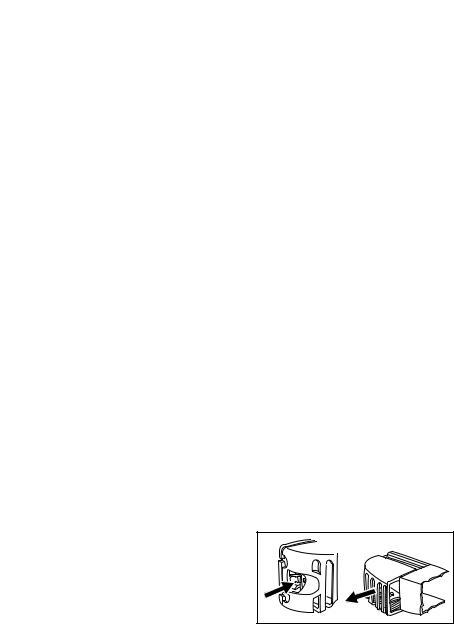
|
|
|
|
|
What to do if… |
|
13 |
|
|
|
|
|
|
|
|
|
|
|
|
|
|
|
|
|
Problem |
|
Possible cause |
|
Solution |
|
|
|
|
|
|
|
|
|
|
|
|
|
The door is not closed correctly. |
|
Refer to "Closing the door". |
|
|
|
|
|
|
|
|
|
|
|
|
|
The Temperature regulator may |
|
Set a higher temperature. |
|
|
|
|
|
be set incorrectly. |
|
|
|
|
|
|
|
|
|
|
|
|
|
The temperature in the |
|
The Temperature regulator may |
|
Set a higher temperature. |
|
|
|
appliance is too low. |
|
be set incorrectly. |
|
|
|
|
|
The temperature in the |
|
The Temperature regulator may |
|
Set a lower temperature. |
|
|
|
appliance is too high. |
|
be set incorrectly. |
|
|
|
|
|
|
|
|
|
|
|
|
|
|
|
The door is not closed correctly. |
|
Refer to "Closing the door". |
|
|
|
|
|
|
|
|
|
|
|
|
|
The product temperature is too |
|
Let the product temperature de- |
||
|
|
|
high. |
|
crease to room temperature be- |
||
|
|
|
|
|
fore storage. |
|
|
|
|
|
Many products are stored at |
|
Store less products at the same |
||
|
|
|
the same time. |
|
time. |
|
|
|
|
|
|
|
|
|
|
|
The temperature in the |
|
There is no cold air circulation |
|
Make sure that there is cold air |
||
|
refrigeration is too high. |
|
in the appliance. |
|
circulation in the appliance. |
|
|
|
|
|
|
|
|
|
|
|
The temperature in the |
|
Products are too near to each |
|
Store products so that there is |
||
|
freezer is too high. |
|
other. |
|
cold air circulation. |
|
|
|
|
|
|
|
|
|
|
|
The appliance does not |
|
The appliance is switched off. |
|
Switch on the appliance. |
|
|
|
operate. |
|
|
|
|
|
|
|
|
|
|
|
|
|
|
|
|
|
The mains plug is not connec- |
|
Connect the mains plug to the |
||
|
|
|
ted to the mains socket correct- |
|
mains socket correctly. |
|
|
|
|
|
ly. |
|
|
|
|
|
|
|
The appliance has no power. |
|
Connect a different electrical ap- |
||
|
|
|
There is no voltage in the mains |
|
pliance to the mains socket. Con- |
||
|
|
|
socket. |
|
tact a qualified electrician. |
|
|
|
The lamp does not work. |
|
The lamp is in stand-by. |
|
Close and open the door. |
|
|
|
|
|
|
|
|
|
|
|
|
|
The lamp is defective. |
|
Refer to "Replacing the lamp". |
||
|
|
|
|
|
|
|
|
If your appliance is still not working properly after making the above checks, contact the After Sales Centre.
Replacing the lamp
1. |
Disconnect the appliance. |
|
|
2. |
Push the movable part to unhook the |
|
|
|
lamp cover (1). |
1 |
2 |
3. |
Remove the lamp cover (2). |
||
4. |
Replace the lamp with one of the same |
|
|
|
power and specifically designed for do- |
|
|
|
mestic appliances only. |
|
|
5.Install the lamp cover.
6.Connect the appliance.
7.Open the door. Make sure that the lamp comes on.

14 Technical data
Closing the door
1.Clean the door gaskets.
2.If necessary, adjust the door. Refer to "Installation".
3.If necessary, replace the defective door gaskets. Contact the Service Center.
TECHNICAL DATA
|
|
|
|
|
|
|
|
Dimension |
|
|
|
|
|
|
|
|
|
Height |
1850 mm |
|
|
|
|
|
|
Width |
595 mm |
|
|
|
|
|
|
Depth |
632 mm |
|
|
||
Rising Time |
|
|
20 h |
|
|
|
|
The technical information are situated in the rating plate on the internal left side of the appliance and in the energy label.
INSTALLATION
WARNING!
Read the "Safety Information" carefully for your safety and correct operation of the appliance before installing the appliance.
Positioning
Install this appliance at a location where the ambient temperature corresponds to the climate class indicated on the rating plate of the appliance:
Climate class |
|
Ambient temperature |
|
|
|
SN |
|
+10°C to + 32°C |
|
|
|
N |
|
+16°C to + 32°C |
ST |
|
+16°C to + 38°C |
|
|
|
T |
|
+16°C to + 43°C |
|
|
|
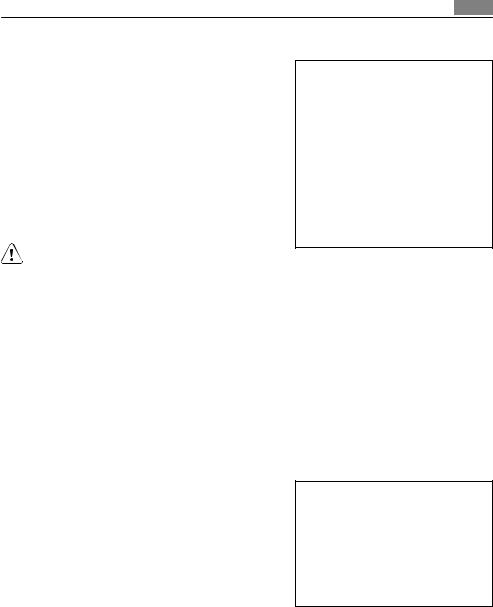
Installation 15
Location
The appliance should be installed well away from sources of heat such as radiators, boilers, direct
sunlight etc. Ensure that air can circulate freely around the back of the cabinet. To ensure best performance, if the appliance is positioned be-
low an overhanging wall unit, the minimum distance between the top of the cabinet and the
wall unit must be at least 100 mm . Ideally, how-
ever, the appliance should not be positioned below overhanging wall units. Accurate levelling is
ensured by one or more adjustable feet at the base of the cabinet.
WARNING!
It must be possible to disconnect the appliance
from the mains power supply; the plug must therefore be easily accessible after installation.
Electrical connection
Before plugging in, ensure that the voltage and frequency shown on the rating plate correspond to your domestic power supply.
The appliance must be earthed. The power supply cable plug is provided with a contact for this purpose. If the domestic power supply socket is not earthed, connect the appliance to a separate earth in compliance with current regulations, consulting a qualified electrician.
The manufacturer declines all responsibility if the above safety precautions are not observed.
This appliance complies with the E.E.C. Directives.
Rear spacers
In the bag with the documentation, there are two spacers which must be fitted as shown in the figure.
Slacken the screws and insert the spacer under the screw head, then tighten again the screws.

16 Installation
Levelling
When placing the appliance ensure that it stands level. This can be achieved by two adjustable feet at the bottom in front.
Removing the shelf holders
Your appliance is equipped with shelf retainers that make it possible to secure the shelves during transportation.
To remove them proceed as follows:
1.Move the shelf holders in the direction of the arrow (A).
2.Raise the shelf from the rear and push it forward until it is freed (B).
3.Remove the retainers (C).
A |
B |
C |
Door reversibility
WARNING!
Before carrying out any operations, remove the plug from the power socket.
To carry out the following operations, we suggest that this be made with another person that will keep a firm hold on the doors of the appliance during the operations.
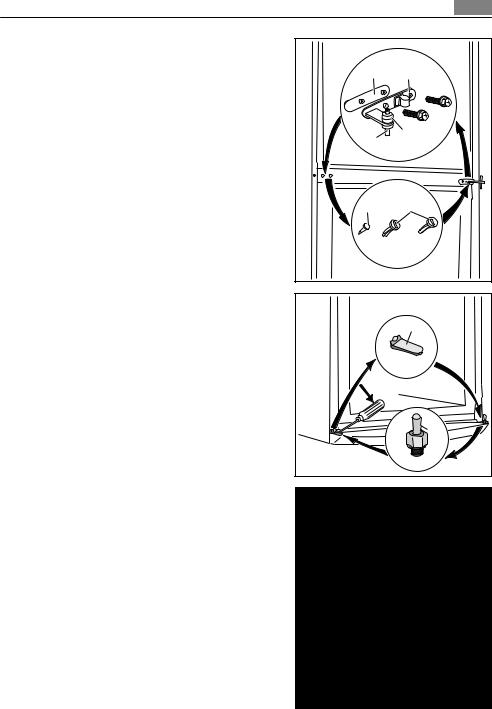
Installation 17
1.Open the doors. Unscrew the middle hinge (m2). Remove the plastic spacer (m1).
2.Remove the spacer (m6) and move to the other side of the hinge pivot (m5).
3.Remove the doors.
4.Remove the left-hand cover pin of the middle hinge (m3,m4) and move to the other side.
5.Fit the pin of the middle hinge (m5) into the left-hand hole of the lower door.
m1 m2
m6
m5
m3 m4
6.Remove using a tool the cover (b1). Unscrew the lower hinge pivot (b2) and the spacer (b3) and place them on the opposite side.
7.Re-insert the cover (b1) on the opposite side.
b1 |
b2 |
b3 |
8.Reverse the door locking elements (d2,d3), move to the other side of the other door and fix by screwing in the screw (d4).
9.Re-insert the stoppers (d5,d6) on the other side of the doors.
d2




d3 d4
 d6
d6
d5
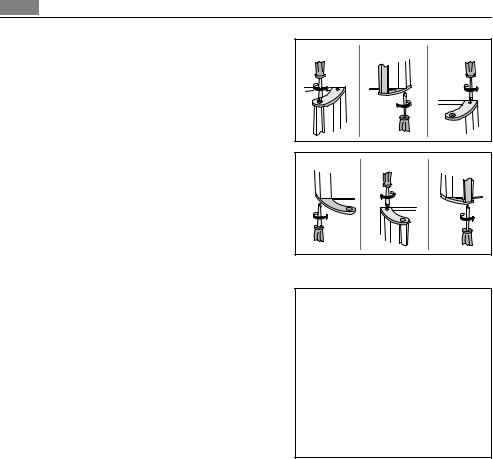
18 |
Environmental concerns |
|
|
|
|
10. Remove the handle. Unscrew the top |
h1 |
h2 |
h3 |
|
handle bracket from the handle rod |
|||
|
|
|
|
|
|
(h1). Unscrew the bottom handle brack- |
|
|
|
|
et from the door (h2) |
|
|
|
|
Unscrew the top handle bracket from |
|
|
|
|
the door (h3). |
|
|
|
|
11. Install the handle in the opposite side. |
h4 |
h5 |
h6 |
|
Re-screw the handle bracket on the |
|||
|
|
|
|
|
|
door (h4). Turn the handle bracket with |
|
|
|
|
the handle and screw them to the door |
|
|
|
|
(h5) and the fitted handle bracket (h6). |
|
|
|
|
12. Re-insert the lower door on the lower |
|
|
|
|
hinge pivot (b2). |
|
|
|
13.Insert the middle hinge (m2) into the left drill of the lower door.
14.Unscrew the upper hinge pivot (t1) and
place it on the opposite side.
15.Fit the upper door on the upper door pivot.
16. |
Re-insert the upper door on the middle |
|
|
hinge pivot (m5) slightly tilting both |
|
|
doors. |
|
17. |
Re-screw the middle hinge (m2). Do |
t1 |
|
not forget the plastic spacer (m1). |
|
Do a final check to make sure that: |
|
|
•All screws are tightened.
•The magnetic seal adheres to the cabinet.
•The door opens and closes correctly.
If the ambient temperature is cold (i.e. in Winter), the gasket may not fit perfectly to the cabinet. In that case, wait for the natural fitting of the gasket.
In case you do not want to carry out the above mentioned operations, contact the nearest After Sales Service Force. The After Sales Service specialist will carry out the reversibility of the doors at your cost.
ENVIRONMENTAL CONCERNS
The symbol  on the product or on its packaging indicates that this product may not be treated as household waste. Instead it should be taken to the appropriate collection point for the recycling of electrical and electronic equipment. By ensuring this product is disposed of correctly, you will help prevent potential negative consequences for the environment and human health, which could otherwise be caused by inappropriate waste handling of this product. For more detailed information about recycling of this product, please contact your local council, your household waste disposal service or the shop where you purchased the product.
on the product or on its packaging indicates that this product may not be treated as household waste. Instead it should be taken to the appropriate collection point for the recycling of electrical and electronic equipment. By ensuring this product is disposed of correctly, you will help prevent potential negative consequences for the environment and human health, which could otherwise be caused by inappropriate waste handling of this product. For more detailed information about recycling of this product, please contact your local council, your household waste disposal service or the shop where you purchased the product.

Sommaire 19
Nous vous remercions d’avoir choisi l’un de nos produits de qualité.
Afin de garantir une performance optimale et constante de votre appareil, veuillez lire attentivement cette notice d'utilisation. Il vous permettra d’utiliser correctement et efficacement toutes les fonctions de l’appareil. Nous vous recommandons de conserver cette notice à proximité pour une utilisation rapide et optimale. Si l'appareil devez être vendu ou cédé à une autre personne, assurezvous que la notice d'utilisation l'accompagne.
Nous vous souhaitons beaucoup de plaisir avec votre nouvel appareil.
SOMMAIRE
CONSIGNES DE SÉCURITÉ |
19 |
|
Sécurité des enfants et des personnes |
|
|
vulnérables |
20 |
|
Mesures générales de sécurité |
20 |
|
Utilisation quotidienne |
21 |
|
Entretien et nettoyage |
21 |
|
Installation |
22 |
|
Maintenance |
22 |
|
FONCTIONNEMENT |
22 |
|
Mise en fonctionnement |
22 |
|
Mise à l'arrêt |
23 |
|
Réglage de la température |
23 |
|
PREMIÈRE UTILISATION |
23 |
|
Nettoyage intérieur |
23 |
|
UTILISATION QUOTIDIENNE |
23 |
|
Congélation d'aliments frais |
23 |
|
Conservation des aliments congelés |
24 |
|
La décongélation |
24 |
|
Clayettes amovibles |
24 |
|
Porte-bouteilles |
24 |
|
Bac à légumes |
25 |
|
Emplacement des balconnets de la porte |
25 |
|
Retrait des paniers de congélation du |
||
|
||
congélateur |
26 |
|
CONSEILS UTILES |
26 |
|
Bruits de fonctionnement normaux |
26 |
Conseils pour l'économie d'énergie |
26 |
Conseils pour la réfrigération de denrées |
|
fraîches |
26 |
Conseils pour la réfrigération |
27 |
Conseils pour la congélation |
27 |
Conseils pour la conservation des produits |
|
surgelés et congelés du commerce |
27 |
ENTRETIEN ET NETTOYAGE |
28 |
Nettoyage périodique |
28 |
Dégivrage du réfrigérateur |
28 |
Dégivrage du congélateur |
29 |
EN CAS D'ANOMALIE DE FONCTIONNEMENT |
30 |
|
|
Remplacement de l'ampoule |
31 |
Fermeture de la porte |
32 |
CARACTÉRISTIQUES TECHNIQUES |
32 |
INSTALLATION |
32 |
Emplacement |
32 |
Emplacement |
33 |
Branchement électrique |
33 |
Entretoises arrière |
33 |
Mise à niveau |
34 |
Retrait des supports de clayette |
34 |
Réversibilité de la porte |
34 |
EN MATIÈRE DE SAUVEGARDE DE |
|
L'ENVIRONNEMENT |
36 |
Sous réserve de modifications
CONSIGNES DE SÉCURITÉ
Pour votre sécurité et garantir une utilisation correcte de l'appareil, lisez attentivement cette notice, y compris les conseils et avertissements, avant d'installer et d'utiliser l'appa-

20 Consignes de sécurité
reil pour la première fois. Pour éviter toute erreur ou accident, veillez à ce que toute personne qui utilise l'appareil connaisse bien son fonctionnement et ses fonctions de sécurité. Conservez cette notice avec l'appareil. Si l'appareil doit être vendu ou cédé à une autre personne, veillez à remettre cette notice au nouveau propriétaire, afin qu'il puisse se familiariser avec son fonctionnement et sa sécurité.
Pour la sécurité des personnes et des biens, conservez et respectez les consignes de sécurité figurant dans cette notice. Le fabricant décline toute responsabilité en cas de dommages dus au non-respect de ces instructions.
Sécurité des enfants et des personnes vulnérables
•Cet appareil n'est pas destiné à être utilisé par des enfants ou des personnes dont les capacités physiques, sensorielles ou mentales, ou le manque d'expérience et de connaissance les empêchent d'utiliser l'appareil sans risque lorsqu'ils sont sans surveillance ou en l'absence d'instruction d'une personne responsable qui puisse leur assurer une utilisation de l'appareil sans danger.
Empêchez les enfants de jouer avec l'appareil.
•Ne laissez pas les différents emballages à portée des enfants. Ils pourraient s'asphyxier.
•Si l'appareil doit être mis au rebut, veillez à couper le câble d'alimentation électrique au ras de l'appareil pour éviter les risques d'électrocution. Démontez la porte pour éviter que des enfants ne restent enfermés à l'intérieur.
•Cet appareil est muni de fermetures magnétiques. S'il remplace un appareil équipé d'une fermeture à ressort, nous vous conseillons de rendre celle-ci inutilisable avant de vous en débarrasser. Ceci afin d'éviter aux enfants de s'enfermer dans l'appareil et de mettre ainsi leur vie en danger.
Mesures générales de sécurité
ATTENTION
Veillez à ce que les orifices de ventilation ne soient pas obstrués.
•Cet appareil est destiné uniquement à la conservation d’aliments et/ou de boissons dans le cadre d’un usage domestique normal, tel que celui décrit dans la présente notice.
•N'utilisez pas d'appareils électriques, d'agents chimiques ou tout autre système artificiel pour accélérer le processus de dégivrage.
•N’utilisez pas d'autres appareils électriques (par exemple, sorbetières) à l'intérieur d’appareils réfrigérants sauf s’ils sont homologués pour cet usage par leur fabricant.
•Faites très attention lorsque vous déplacez l'appareil afin de ne pas endommager des parties du circuit de refroidissement et ainsi d'éviter des risques de fuite.
•Le circuit de refroidissement de l’appareil contient de l’isobutane (R600a), un gaz naturel offrant un haut niveau de compatibilité avec l’environnement mais qui est néanmoins inflammable.
Pendant le transport et l'installation de l’appareil, assurez-vous qu'aucune pièce du circuit de refroidissement n'est endommagée.
Si tel est le cas :
–Évitez les flammes vives (briquet) et tout autre allumage (étincelles).
–Aérez soigneusement la pièce où se trouve l'appareil.
•Ne modifiez pas les spécifications de l'appareil. Un cordon d'alimentation endommagé peut être la cause de courts-circuits, d'incendies et/ou de décharges électriques.

Consignes de sécurité |
21 |
|
|
AVERTISSEMENT
Les composants électriques (cordon d'alimentation, prise, compresseur) doivent être remplacés par un technicien d’entretien agréé ou par un électricien spécialisé.
1.L'appareil ne doit pas être raccordé à l'aide d'un prolongateur, d'une prise multiple ou d'un raccordement multiple (risque d'incendie).
2.Assurez-vous que la prise n'est pas écrasée ou endommagée par l'arrière de l'appareil. Une prise de courant endommagée peut surchauffer et provoquer un incendie.
3.Vérifiez que la prise murale reste accessible une fois que l'installation est terminée.
4.Ne débranchez pas l'appareil en tirant sur le câble, particulièrement lorsque l'appareil est tiré de son logement.
5.Si la fiche du cordon d'alimentation est desserrée, ne la branchez pas dans la prise murale. Risque d'électrocution ou d'incendie !
6.N'utilisez pas l'appareil si le diffuseur de l'ampoule d'éclairage n'est pas présent. 5) pour l'éclairage intérieur.
•Cet appareil est lourd. Faites attention en le déplaçant.
•Ne touchez pas avec les mains humides les surfaces givrées et les produits congelés (risque de brûlure et d'arrachement de la peau).
•Évitez une exposition prolongée de l'appareil aux rayons solaires.
•Ampoules 6) utilisées dans cet appareil sont des ampoules spéciales dédiées uniquement à un usage avec des appareils ménagers. Elles ne conviennent pas à l'éclairage des pièces d'une habitation.
Utilisation quotidienne
•Ne posez pas d'éléments chauds sur les parties en plastique de l'appareil.
•Ne stockez pas de gaz ou de liquides inflammables dans l'appareil (risque d'explosion).
•Ne placez pas d'aliments directement contre la sortie d'air sur la paroi arrière de l'appareil. 7)
•Un produit décongelé ne doit jamais être recongelé.
•Conservez les aliments emballés conformément aux instructions de leur fabricant.
•Respectez scrupuleusement les conseils de conservation donnés par le fabricant de l'appareil. Consultez les instructions respectives.
•Ne mettez pas de bouteilles ni de boîtes de boissons gazeuses dans le compartiment congélateur, car la pression se formant à l'intérieur du contenant pourrait le faire éclater et endommager ainsi l'appareil.
•Ne consommez pas certains produits tels que les bâtonnets glacés dès leur sortie de l'appareil, car ils peuvent provoquer des brûlures.
Entretien et nettoyage
•Avant toute opération d'entretien, mettez l'appareil hors tension et débranchez-le de la prise de courant.
•N'utilisez pas d'objets métalliques pour nettoyer l'appareil.
•N'utilisez pas d'objet tranchant pour gratter la couche de givre. Utilisez une spatule en plastique.
5)Si le diffuseur est prévu
6)Si l'ampoule est équipée d'un diffuseur d'éclairage.
7)Si l'appareil est sans givre

22Fonctionnement
•Contrôlez régulièrement l'orifice d'évacuation de l'eau de dégivrage dans le compartiment réfrigérateur. Nettoyez-le, si besoin. Si l'orifice est bouché, l'eau s'écoulera en bas de l'appareil.
Installation
Avant de procéder au branchement électrique, respectez scrupuleusement les instructions fournies dans cette notice.
•Déballez l'appareil et vérifiez qu'il n'est pas endommagé. Ne branchez pas l'appareil s'il est endommagé. Signalez immédiatement au revendeur de l'appareil les dommages constatés. Dans ce cas, gardez l'emballage.
•Il est conseillé d'attendre au moins quatre heures avant de brancher l'appareil pour que le circuit frigorifique soit stabilisé.
•Veillez à ce que l'air circule librement autour de l'appareil pour éviter qu'il ne surchauffe. Pour assurer une ventilation suffisante, respectez les instructions de la notice (chapitre Installation).
•Placez l'appareil dos au mur pour éviter tout contact avec le compresseur et le condenseur (risque de brûlure).
•Placez de préférence votre appareil loin d'une source de chaleur (chauffage, cuisson ou rayons solaires trop intenses).
•Assurez-vous que la prise murale reste accessible après l'installation de l'appareil.
•Branchez à l'alimentation en eau potable uniquement. 8)
Maintenance
•Les branchements électriques nécessaires à l'entretien de l'appareil doivent être réalisés par un électricien qualifié ou une personne compétente.
•Cet appareil ne doit être entretenu et réparé que par un Service après-vente autorisé, exclusivement avec des pièces d'origine.
Protection de l'environnement
Le système frigorifique et l'isolation de votre appareil ne contiennent pas de C.F.C. contribuant ainsi à préserver l'environnement. L'appareil ne doit pas être mis au rebut avec les ordures ménagères et les déchets urbains. La mousse d'isolation contient des gaz inflammables : l'appareil sera mis au rebut conformément aux règlements applicables disponibles auprès des autorités locales. Veillez à ne pas détériorer les circuits frigorifiques, notamment au niveau du condenseur. Les matériaux utilisés dans cet appareil identifiés par le symbole  sont recyclables.
sont recyclables.
FONCTIONNEMENT
Mise en fonctionnement
Branchez l'appareil sur une prise murale.
Tournez le bouton du thermostat dans le sens des aiguilles d'une montre sur une position moyenne.
8) Si un branchement sur le réseau d'eau est prévu

Première utilisation |
23 |
|
|
Mise à l'arrêt
Pour mettre à l'arrêt l'appareil, tournez le bouton du thermostat sur la position "O".
Réglage de la température
La température est réglée automatiquement.
Pour faire fonctionner l'appareil, procédez comme suit :
•tournez le bouton du thermostat vers le bas pour obtenir un réglage de froid minimum.
•tournez le bouton du thermostat vers le haut pour obtenir un réglage de froid maximum.
Une position moyenne est la plus indiquée.
Toutefois, le réglage doit être choisi en tenant compte du fait que la température à l'intérieur de l'appareil dépend de plusieurs facteurs :
•la température ambiante
•la fréquence d'ouverture de la porte
•la quantité de denrées stockées
•l'emplacement de l'appareil.
Si le thermostat est réglé sur la position de froid maximum, lorsque la température ambiante est élevée et que l'appareil est plein, il est possible que le compresseur fonctionne en régime continu. Dans ce cas, il y a un risque de formation excessive de givre sur la paroi postérieure à l'intérieur de l'appareil. Pour éviter cet inconvénient, placez le thermostat sur une température plus élevée de façon à permettre un dégivrage automatique et, par conséquent, des économies de courant.
PREMIÈRE UTILISATION
Nettoyage intérieur
Avant d'utiliser l'appareil pour la première fois, nettoyez l'intérieur et tous les accessoires internes avec de l'eau tiède savonneuse pour supprimer l'odeur caractéristique du "neuf" puis séchez soigneusement.
N'utilisez pas de produits abrasifs, poudre à récurer, éponge métallique pour ne pas abîmer la finition.
UTILISATION QUOTIDIENNE
Congélation d'aliments frais
Le compartiment congélateur est idéal pour congeler des denrées fraîches et conserver les aliments surgelés ou congelés pendant longtemps.
Pour congeler les denrées fraîches, il n'est pas nécessaire de modifier le réglage moyen. Toutefois, pour une congélation plus rapide, tournez le bouton du thermostat vers le haut pour obtenir un réglage de froid maximum.
Dans ce cas, la température du compartiment réfrigérateur peut chuter au-dessous de 0°C. Si cela se produit, repositionnez le bouton du thermostat sur un réglage plus chaud.
